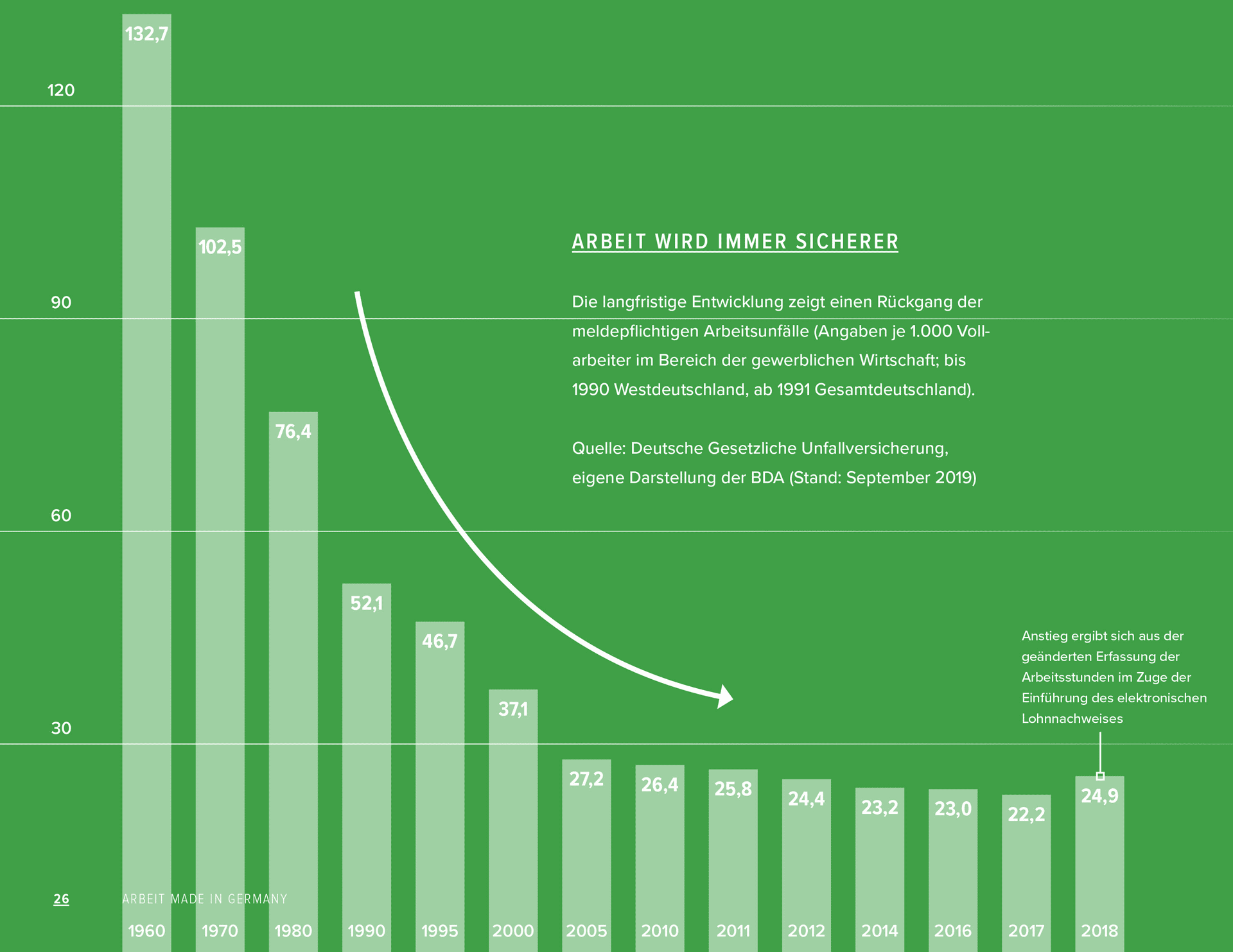Occupational health and safety and workplace health promotion
Work not only provides a livelihood, it also gives meaning, makes people happy and ensures social recognition. Employers want their employees to be fit, productive and willing to perform well into retirement age - and therefore invest a lot in the safety and health of their employees.

©AdobeStock Ipopba
There are fewer and fewer accidents at work
Work is getting safer. Since 1970, the number of workplace accidents per 1,000 full-time workers has dropped from nearly 103 accidents to just 23.5 (2019). That's a 77% decrease. The number of fatal occupational accidents has even fallen by two thirds during this time (DGUV, 2020). In a European comparison, Germany is well below the EU average for occupational accidents (Eurostat, 2018) and fatal occupational accidents (Eurostat, 2019). The number of employees leaving the workforce prematurely for health reasons has decreased by 45% since 1995 (Deutsche Rentenversicherung, 2021). At 4.3%, the sickness rate for those with statutory health insurance was at a lower level in 2019 than when sick pay was introduced in 1970 and after German unification in 1990 (Bundesgesundheitsministerium, 2020). The investments in safety and health at work by employers, the statutory accident insurance and the health insurance funds have therefore paid off, and have brought down the level of absenteeism due to occupational accidents substantially.
Occupational health and safety is a duty, workplace health promotion the freestyle
The risk assessment is the basic instrument in occupational safety for all companies. Here, hazards - e.g. in relation to chemicals, musculoskeletal and mental stress - are identified at work, documented, measures to eliminate them are implemented and their success is also monitored. In a representative survey conducted by the Joint German Occupational Safety and Health Strategy, 80% of those responsible for occupational safety and health stated that a risk assessment is carried out at workplaces in their company (NAK & BAuA, 2017). Employers use the risk assessment to identify the necessary occupational health and safety measures. These OSH measures include work design measures. And here, too, companies are demonstrably very committed: For example, 90 percent of establishments meet the minimum standard of an ergonomically designed workplace, of which about half were optimally designed. Only in 1 percent of the companies were ergonomically unfavourably designed workplaces found. Even in small companies, there is often a healthy work design (GDA, 2018).
Nevertheless, there is still room for improvement in the implementation of risk assessment: for example, in companies participating in the so-called "entrepreneur model" (alternative supervision in accordance with DGUV Regulation 2), risk assessments are carried out twice as often as in other SMEs (BAuA, 2015). In some cases, micro and small enterprises do not have a sufficiently documented risk assessment. In order to provide support here, suitable action aids are needed that contain all the essential information on occupational safety and health for specific sectors.
If occupational health and safety is the duty, then workplace health promotion is the freestyle, in which an increasing number of companies are voluntarily participating with a wide range of measures. A share of 45% of employed persons in 2018 compared to 34% in 2006 state that workplace health promotion measures are offered in their company (Lück et al. 2019). More than half of the respondents also take advantage of such offers. Employers' associations also support these efforts. The financial expenditure of companies on prevention and health protection is considerable: of around 14.3 billion euros spent in total on prevention and health protection in 2019, companies - in addition to the state and private households - spent around 6.5 billion euros, or 46 % of the total (Health Expenditure Accounts of the Federal Statistical Office, 2021).
New challenges also for employees: personal responsibility is growing
New forms of work offer the opportunity for employees to take (more) responsibility for their own work and thus the chance to better reconcile areas of life. Together with the growing personal responsibility, the role of the health competence of employees is growing. This competence includes, among other things, the knowledge of a favourable design of working conditions. The employer can provide suitable work equipment for mobile working, instruct employees in its use and offer workshops on correct sitting or time management. However, employees must then take care of the implementation themselves - be it in a home office, café, coworking space or on the train.
But: 60% of the population in Germany has only low health literacy (Health Literacy Survey Germany, 2021). It has been proven that low health literacy is associated, for example, with poor nutrition, little exercise and more days of absence from work. This makes it clear: employers have limited options when it comes to preventing work-related illnesses. People also have a lot in their own hands through health literate actions and their health literate choices.
The best ideas for occupational safety and the creative minds behind them are regularly honored at the German Occupational Safety Award. Applications can be submitted here: www.deutscher-arbeitsschutzpreis.de
PDFs on the topic
Facts and figures
The long-term development shows a decline in the number of notifiable occupational accidents (data per 1,000 full-time workers in the commercial sector; until 1990 West Germany, from 1991 Germany as a whole).
Source: German Social Accident Insurance, BDA's own presentation (as of 2020)









